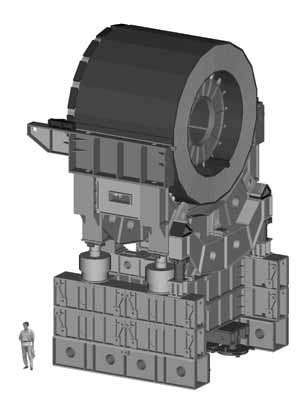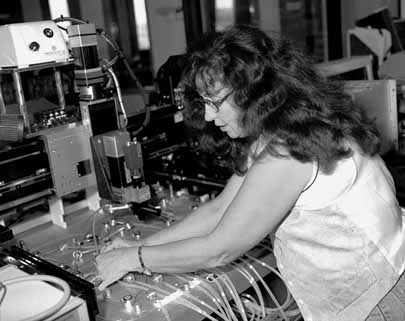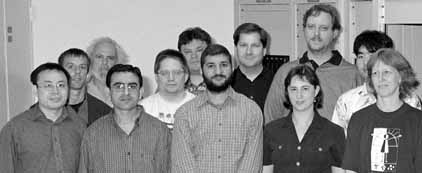 |
|
CMS: Chasing Supersymmetry by Kurt Riesselmann
Discoveries of a new family of matter particles seem to happen only once per century:
Obviously, the third discovery hasn't actually happened yet, but the pace of discovery is accelerating. The Large Hadron Collider at the European particle physics laboratory CERN could make this dream come true if evidence for supersymmetry has not already appeared in Run II at Fermilab's Tevatron. Supersymmetry, a popular theoretical concept that predicts all force particles to have complementary matter particles, could emerge as a universal physics principle when LHC starts operations in 2006. The gluon, the messenger particle of the quark-binding force, would finally meet the gluino, its matter partner.
"You really have to be ready on Day One," said Fermilab physicist Dan Green. "Within a month of LHC operations you could find SUSY particles. SUSY is one of the things that really benefit from the much higher energy of the LHC compared to the Tevatron."
The LHC will create proton-proton collisions at energies seven times higher than the collisions produced by Fermilab's Tevatron accelerator. According to Einstein's famous energy-mass-relationship, E=mc2, the LHC is capable of producing particles heavier than anything ever seen before. That could include SUSY particles.
Observing those particles requires a new generation of detectors. The LHC ring, 27 kilometers in circumference, will initially have two general purpose detectors: CMS and ATLAS. In a global effort, American universities and national laboratories are contributing hardware and software to both. Green is the project manager of the U.S. contributions to CMS. Funding comes from the Department of Energy and the National Science Foundation. DOE contributes a total of $240 million to the two detectors, matched with $80 million from NSF. Northeastern University professor Steve Reucroft manages the NSF funding for ten universities working on the CMS project.
Fermilab participates in design and construction of the CMS detector, which will be built around the largest superconducting magnet in the world, a 12-meter-long and 7-meter-diameter cylindrical coil called the Compact Muon Solenoid. The complete CMS detector will stand 15 meters high, measure almost 22 meters long and weigh about 12,500 tons.
Measuring particle properties
The superconducting magnet at the core of the CMS design helps scientists to determine the particles' charge. Cooled to two kelvins and producing a four-Tesla magnetic field, the magnet bends the path of charged particles traversing its field. Depending on their charge, positive or negative, the magnet pushes the particles in different, easily distinguishable directions. Neutral particles are unaffected.
Particles crossing the calorimeter interact with the high-density brass and produce light. The amount of light created is a measure of the kinetic energy of the particles. The scintillators collect the light and transform it into electrical signals that are recorded for analysis.
The design of the CMS experiment requires the 1,600-ton calorimeter to rest inside the cylindrical shell of the superconducting magnet.
"It is more complicated than building a bridge," said Igor Churin, a mechanical engineer who worked on the design. "Brass is not as stiff as steel. As a result, the barrels, which rest on beams attached on the side, tend to sag at the bottom. It took a lot of work to minimize this effect."
At the beginning of the year, the manufacturer of the barrels, the Spanish company Felguera, passed a crucial quality control test when it successfully completed the trial assembly of the first barrel. It then disassembled the barrel and shipped it to CERN, where the final assembly will take place in August. Sliding the barrels into the shell of the superconducting magnet will be the next challenging job.
"We have to align the support beams of the barrels and the tracks inside the magnet's shell to better than one tenth of a millimeter," said Churin. "For that purpose we put each barrel onto a movable cradle. Heavy jacks will lift the barrels to the correct height. The challenge is to maintain the alignment while each barrel is sliding in and loads are shifting."
Silicon for particle tracking
The Tracker contains, among other systems, a silicon microstrip detector. Its silicon sensors produce electrical impulses when charged particles cross. The CMS detector will feature 24,000 silicon panels that contain more than 500 microstrips each.
Precise positioning of the panels within the detector is important to obtain accurate measurements of particle tracks. Fermilab purchased the first of two robots that will glue pairs of panels to a support frame, which eventually will go into a cylindrical support structure. The first robot, which will be fully functional by the end of the summer, is capable of positioning the panels within two thousandths of a millimeter.
"We still need to install software," said Bill Kahl, a postdoc from Kansas State University. "Since no two robots are identical, we may need to make minor modifications to adjust for mechanical variations."
It will take a robot about five minutes to carefully glue two panels and an electrical circuit onto a U-shaped frame, producing a single module.
"The CMS detector will contain fifteen thousand silicon modules," said Lenny Spiegel, who is in charge of setting up the silicon production facility at the laboratory. "Fermilab is responsible for building five thousand of two-panel modules."
Using a process called micro-bonding, technicians next will apply electrical connections between the microstrips and the electronic chips that amplify and transmit the signals from particles for recording.
Global computing power
Analyzing this vast amount of data will require enormous computing power, more than a single laboratory can handle. CMS has developed a tiered computing model, with only a third of the total off-line computing power at CERN, the "Tier 0" site. Another third will be in five "Tier 1" sites around the globe. Fermilab will be the U.S. Tier 1 center, with others in France, Italy, the United Kingdom and Germany. The final portion will be located in "Tier 2" sites. Five Tier 2 sites are planned for the U.S.
"Fermilab and Italy have already started working on their Tier 1 sites," said Vivian O'Dell, the head of the CMS computing group in Fermilab's Computing Division. "Those sites will be responsible for data handling and archiving in an easy format for physicists to use along with some Monte Carlo simulations. Then there are Tier 2 sites that mainly do final data analyses and Monte Carlo production, and provide data to individual physics groups. The first prototype Tier 2 site already exists, a joint project of UC San Diego and CalTech. And the University of Florida just started work on a second prototype. "
Each Tier 1 center will spend about $8 million for new computing hardware, roughly the equivalent cost to satisfy the computing needs for each of Fermilab's collider experiments for Run II, CDF and DZero.
Plans for a physics center
"I've been pushing to have a CMS remote control room and physics center in the United States," said Green. "We would try to do the CERN night shifts from the U.S. during daytime. This is possible, since all operations are remotely controlled. Establishing an analysis center here at Fermilab also would make it easy for CDF and DZero physicists to join the CMS experiment when the time comes. The U.S. effort in the LHC will be THE effort in U.S. high-energy physics for quite some time. That's where people will be working."
At present, the CMS collaboration includes about 375 U.S. scientists from 38 universities. Green expects about 700 U.S. physicists to be working on CMS in 2006 when the LHC collider will have its first proton beams.
"ATLAS and CMS are now the largest capital-investment projects going on in U.S. high-energy physics," Green said. "To me, it's extremely important that we capitalize fully on this investment by doing the physics well in the U.S."
In return, the LHC and its two detectors would be primed to continue accelerating the pace of discovery.
On the web:
|
| last modified 7/9/2001 by C. Hebert email Fermilab |
FRLsDFx9eyfrPXgV
 To determine the particles' kinetic energy, scientists use calorimeters. The CMS detector design features a calorimeter, called HCAL, consisting of two 500-ton cylinders made of brass plates. The brass structure, held together by 80,000 bolts, has slots filled with sheets of scintillating plastic.
To determine the particles' kinetic energy, scientists use calorimeters. The CMS detector design features a calorimeter, called HCAL, consisting of two 500-ton cylinders made of brass plates. The brass structure, held together by 80,000 bolts, has slots filled with sheets of scintillating plastic.

